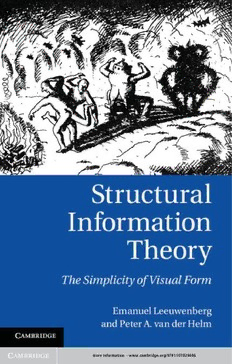Table Of Contentmore information - www.cambridge.org/9781107029606
Structural Information Theory
TheSimplicityofVisualForm
Structural information theory is a coherent theory about the way the
human visual system organizes a raw visual stimulus into objects and
objectparts.Tohumans,avisualstimulususuallyhasoneclearinter-
pretation even though, in theory, any stimulus can be interpreted in
numerous ways. To explain this, the theory focuses on the nature of
perceptual interpretations rather than on underlying process mecha-
nisms,andadoptsthesimplicityprinciple,whichpromotesefficiencyof
internalresources,ratherthanthelikelihoodprinciple,whichpromotes
veridicalityintheexternalworld.Thistheoreticallyunderpinnedstart-
ingpointgivesrisetoquantitativemodelsandverifiablepredictionsfor
manyvisualphenomena,includingamodalcompletion,subjectivecon-
tours, transparency, brightness contrast, brightness assimilation, and
neon illusions. It also explains phenomena such as induced temporal
order,temporalcontexteffects,andhierarchicaldominanceeffects,and
extendstoevaluativepatternqualitiessuchasdistinctiveness,interest-
ingness,andbeauty.
emanuel leeuwenberg is Emeritus Associate Professor at the
Donders Institute for Brain, Cognition and Behaviour at Radboud
UniversityNijmegen,TheNetherlands.
peter a. van der helm is Assistant Professor at the Donders
Institute for Brain, Cognition and Behaviour at Radboud University
Nijmegen,TheNetherlands.
Structural Information Theory
The Simplicity of Visual Form
Emanuel Leeuwenberg
Peter A. van der Helm
cambridge university press
Cambridge,NewYork,Melbourne,Madrid,CapeTown,
Singapore,Sa˜oPaulo,Delhi,MexicoCity
CambridgeUniversityPress
TheEdinburghBuilding,CambridgeCB28RU,UK
PublishedintheUnitedStatesofAmericabyCambridgeUniversityPress,
NewYork
www.cambridge.org
Informationonthistitle:www.cambridge.org/9781107029606
(cid:2)C EmanuelLeeuwenbergandPeterA.vanderHelm2013
Thispublicationisincopyright.Subjecttostatutoryexception
andtotheprovisionsofrelevantcollectivelicensingagreements,
noreproductionofanypartmaytakeplacewithoutthewritten
permissionofCambridgeUniversityPress.
Firstpublished2013
PrintedandboundintheUnitedKingdombytheMPGBooksGroup
AcataloguerecordforthispublicationisavailablefromtheBritishLibrary
LibraryofCongressCataloguinginPublicationdata
Leeuwenberg,E.L.J.(EmanuelLaurensJan)author.
Structuralinformationtheory:thesimplicityofvisualform/
EmanuelLeeuwenberg,PeterA.vanderHelm.
pages cm
Includesbibliographicalreferencesandindex.
ISBN978-1-107-02960-6(hardback)
1.Humaninformationprocessing. 2.Informationtheoryinpsychology.
I.Helm,PeterA.vander,author. II.Title.
QP396.L44 2013
612.8–dc23 2012020254
ISBN978-1-107-02960-6Hardback
CambridgeUniversityPresshasnoresponsibilityforthepersistenceor
accuracyofURLsforexternalorthird-partyinternetwebsitesreferredto
inthispublication,anddoesnotguaranteethatanycontentonsuch
websitesis,orwillremain,accurateorappropriate.
Contents
Figures pagevii
Tables xiv
Preface xv
Introduction 1
PartI Towardsatheoryofvisualform
1 Bordersofperception 9
1.1 Thestimulus 9
1.2 Knowledge 16
2 Attributesofvisualform 24
2.1 Features 24
2.2 Dimensions 27
2.3 Transformations 34
2.4 Gestaltproperties 38
3 Processversusrepresentation 45
3.1 Processcriteria 45
3.2 Representationcriteria 51
4 Modelsandprinciples 64
4.1 Tworepresentationmodels 64
4.2 Twoperceptionprinciples 74
5 Assumptionsandfoundations 83
5.1 Visualinformationprocessing 83
5.2 Mentalandsymboliccodes 86
5.3 Theoreticalfoundations 91
PartII Applicationstovisualform
6 Formalcodingmodel 109
6.1 Structuralinformation 109
6.2 Attributesofsimplestcodes 113
v
vi Contents
7 Aperceptualcodingmanual 120
7.1 Linedrawings 121
7.2 Surfaces 127
7.3 Objects 134
8 Preferenceeffects 147
8.1 Occludinglayers 148
8.2 Translucentlayers 156
8.3 Rivalry 171
9 Timeeffects 181
9.1 Inducedtemporalorder 181
9.2 Inducedsimultaneity 189
10 Hierarchyeffects 198
10.1 Superstructuredominance 198
10.2 Mentalrotation 204
10.3 Orientationframes 216
PartIII Extensions
11 PerceptionbeyondSIT 224
11.1 Metricalinformation 224
11.2 Imageversusmirror-image 234
12 SITbeyondperception 251
12.1 Alphabeticletterseries 251
12.2 Evaluativepatternqualities 260
Overview 283
Conclusion 291
References 297
Authorindex 313
Subjectindex 317
Thecolourplatesaresituatedbetweenpages208and209.
Figures
I.1 AMaxwelldemonwho,likeperception,turnschaosinto
order page2
I.2 Thedifferencebetweenstructuralandmetrical
information 4
1.1 Eightobjectimageswhicharehardlyidentifiableas
differentviewsofthesameobject 10
1.2 Stimulusobjectsinvolvedinimageversusmirror-image
discriminationexperiments 11
1.3 Imageversusmirror-imagediscriminationiseasierfor
simpleobjectsthanforcomplexobjects 13
1.4 Differentviewsofaprismcanbeimaginedduetoits
view-independentrepresentation 13
1.5 Judgedlikelihoodsofconfigurationspresuppose
classificationoftheseconfigurations 14
1.6 Theperceptualrepresentationofapartlyoccluded
patternisequivalenttothatofthecompletedpattern 15
1.7 Consciousreasoningandperceptionmayleadto
differentcompletionsofoccludedpatterns 15
1.8 AGestaltisdeterminednotonlybyitspartsbutalsoby
therelationshipsbetweentheseparts 17
1.9 Onlyprimesshowingperceptuallyplausibletargetparts
mayaffectthetargetinterpretation 17
1.10 Specificknowledgemayfavouraspecificvisually
plausibleinterpretationofapattern 18
1.11 Apatternmaygiverisetoafewplausibleinterpretations
andmanyimplausibleones 20
2.1 Featurecomplexityandvisualcomplexityareopposite
functionsofsetsize 27
2.2 Thetriangularinequalityintermsofpatterndifferences
doesnotholdinperception 29
2.3 Prototypesareeitherunambiguouspatternsorsimple
patterns 30
vii
viii Figures
2.4 Distinctivestructuresaremoresalientbutcommon
structuresareprimary 32
2.5 Inmotionpatterns,commonstructurestendtobe
suppressedgradually 33
2.6 Stepwiseconstructionofapatternbywayofrigid
transformationsofparts 34
2.7 Partlyoverlappingregularitiesinapatterncannotbe
combinedintoonerepresentation 40
2.8 Threeoptionsforrepresentingsegmentsandregularities 40
2.9 Patterninterpretationsdependontheactualstrengthsof
Gestaltcuesinpatterns 42
3.1 Acaseinwhichminimalcomplexityperstageprevails
overmaximalclusterperstage 46
3.2 Acaseinwhichmaximalclusterperstageprevailsover
minimalcomplexityperstage 46
3.3 Examplesofpatternsfromtherestrictedapplication
domainoftheglobalprecedencehypothesis 49
3.4 Examplesofpatternstowhichtheglobalprecedence
hypothesisdoesnotapply 50
3.5 Clusteringofrandomlypositionedsubpatternsonthe
basisoftheirorientations 51
3.6 Hierarchyinpatterncodesspecifiesrelationsbetween
superstructuresandsubordinatestructures 52
3.7 Hierarchyinobjectcodesspecifiesrelationsbetween
superstructuresandsubordinatestructures 54
3.8 Thesuperstructureinanobjectcodedoesnotalways
coincidewiththelargestobjectcomponent 54
3.9 Thesuperstructureofparalleloriented2-D
substructuresisthelargestpatterncomponent 55
3.10 Thesuperstructureofparalleloriented3-D
substructuresisthelargestobjectcomponent 56
3.11 Thehierarchicallyhighestdistinctivecodecomponent
determinestheclusteringofsubpatterns 57
3.12 Structuralhierarchyprevailsovermetricalhierarchy 59
3.13 Structuralhierarchyguaranteesobjectinvarianceunder
rotationofsuperstructures 60
3.14 Spatialcontiguitytendstoexcludemetrically
hierarchicalcodes 61
3.15 Objectsdescribableonlybymetricalhierarchytendtobe
oddandnotspatiallycontiguous 62
4.1 RBCattributesforthecross-sectionsandaxes
ofgeonobjects 65

